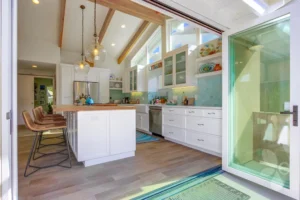Planning major renovations in California can be an exciting but complex process. With everything from strict building codes to California’s unique environmental considerations, success depends on careful preparation.
Whether reimagining your home’s layout or upgrading essential systems, having a solid plan is crucial, every step requires attention to detail, from securing the necessary permits to managing the design and finding the right contractors.
This comprehensive checklist will guide you through each phase of renovation planning, ensuring your project runs smoothly and efficiently. By following this guide, you’ll be better equipped to tackle any challenges and transform your space while staying within budget and on schedule.
Step 1: Define Your Renovation Goals and Vision
Assess Your Space and Set Clear Objectives 
The first step in any major renovation project is to define your goals and vision. Start by assessing the space you want to transform. Are you focusing on specific rooms, like the kitchen or bathroom, or is this a full-home renovation? Understanding the renovation’s scope will give you a clear direction from the beginning. Take a close look at your current space to identify what works and what could be improved—whether in functionality, layout, or overall aesthetics.
Determine the Type of Renovation
Next, decide on the type of renovation you’re planning. Is it primarily structural, requiring major changes like removing walls or adding new rooms? Or is it aesthetic, involving updates such as new flooring, fixtures, or paint? Structural renovations usually require more detailed planning and can involve higher costs due to changes in the home’s layout or foundation. In contrast, aesthetic upgrades focus on improving the appearance and feel of the space while keeping the existing structure intact.
Set Clear Objectives
Once you’ve assessed your space and identified the renovation type, set clear objectives. Are you looking to increase property value, enhance functionality, or modernize outdated areas? Creating a list of essential upgrades versus optional improvements will help guide your decisions throughout the process. Prioritizing must-haves versus nice-to-haves ensures you stay on track with both your budget and timeline.
By defining your renovation goals early on, you’ll be able to communicate your vision effectively to contractors and designers, laying the groundwork for a successful and well-organized project.
Step 2: Create a Realistic Budget
Estimating Costs for Major Renovations
A well-planned budget is essential for any major renovation, as it helps you stay on track financially and avoid surprises. Begin by estimating costs for the critical components of your project. These typically include materials, labor, permits, and any contingencies.
Consider the quality you desire for materials. High-end finishes like marble countertops or custom cabinetry will significantly increase costs compared to standard options. Labor costs will depend on the complexity of the renovation and the rates charged by contractors in your area.
It’s also essential to account for California-specific factors impacting your budget. For example, if your renovation involves structural changes, you may need to invest in earthquake-resistant materials to comply with building codes.
Additionally, California’s emphasis on sustainability could lead you to choose energy-efficient windows, solar panels, or eco-friendly materials, which may raise the initial costs but offer long-term savings. Building permits are another significant expense in California, and the price will vary depending on the scope and location of the project.
A bright tip is to allocate 10-15% of your budget for unexpected expenses. Renovation projects often encounter unforeseen challenges, such as hidden water damage or outdated wiring, requiring additional time and money.
By reserving a portion of your budget for these contingencies, you’ll be better prepared to handle surprises without derailing the entire project. With a realistic and flexible budget, you can approach your renovation confidently, knowing you have the financial resources to complete it.
Step 3: Understand California Building Codes and Permits
Securing the Necessary Permits
Securing the proper permits is a critical step in any major renovation in California. Each city and county may have specific requirements, so it’s essential to research the regulations for your area before starting your project.
Joint permits include those for electrical work, plumbing, structural changes, and sometimes even aesthetic upgrades, depending on the extent of the renovation. Without these permits, you risk fines, project delays, or even being forced to undo the work.
California’s permit process often involves multiple steps, including submitting detailed renovation plans for approval. Be prepared for inspections at different stages of the renovation to ensure that the work complies with local building codes. These inspections can occur during construction and after the project is completed.
For instance, if you’re remodeling a kitchen, inspectors might check electrical wiring and plumbing systems mid-project and then revisit to approve the final installation of appliances and fixtures.
Special considerations may also apply depending on the location of your home. For example, if you live in a coastal area, you may need additional approvals to protect sensitive environmental zones. These regulations are designed to preserve natural resources and reduce the impact of development on the coastline.
Similarly, if your project involves earthquake-prone areas, you might be required to include specific structural reinforcements. By fully understanding and complying with California’s building codes and permit requirements, you can avoid unnecessary setbacks and ensure your renovation meets legal standards.
Step 4: Select the Right Contractor
How to Vet and Hire a Contractor in California
Choosing the right contractor is one of the most important decisions when planning major renovations in California. Review potential contractors’ portfolios to ensure they have experience with similar projects. Look for detailed examples of their work, especially renovations that align with your design vision and complexity.

It’s also essential to ask for references from previous clients. A reputable contractor will have no problem providing these, and speaking with past clients can give you valuable insights into their work quality, professionalism, and ability to stay on budget and schedule.
In California, verifying your contractor’s license is crucial. You can do this by checking the California Contractors State License Board (CSLB) records to ensure the contractor is appropriately licensed, bonded, and insured. This step helps protect you from unlicensed or underqualified individuals who could put your project at risk.
The CSLB also allows you to check if there have been any disciplinary actions or complaints against the contractor. It’s a good idea to ensure that their insurance covers any liabilities or damages that might occur during the renovation.
Another factor to consider is the contractor’s local expertise. A contractor with experience in your city will be more familiar with local building codes, permit processes, and inspection requirements.
This local knowledge can save you time and money, as the contractor will know how to navigate city permits efficiently. By thoroughly vetting contractors and focusing on those with relevant experience and strong references, you’ll set your renovation up for success.
Step 5: Prioritize Sustainable Renovation Options
California’s Green Building Standards
Incorporating sustainability into your renovation is environmentally responsible and can result in long-term savings. California’s Green Building Standards (CALGreen) encourage homeowners to integrate eco-friendly elements into their projects.
You can prioritize sustainability by choosing energy-efficient solutions like installing solar panels, using recycled or sustainably sourced building materials, and incorporating water-saving fixtures. These upgrades help reduce your carbon footprint while making your home more energy-efficient and cost-effective.
California homeowners can also take advantage of various state incentives for energy-efficient upgrades. Programs like the California Solar Initiative offer rebates for installing solar energy systems, while the Energy Upgrade California initiative provides financial support for making energy-efficient home improvements.
Incorporating these eco-friendly features not only helps the environment but can also increase the overall value of your property.
Additionally, sustainable renovations in California often extend beyond energy and water efficiency. Many homeowners opt for low-VOC (volatile organic compounds) paints and finishes to improve indoor air quality or choose drought-resistant landscaping to conserve water.
By aligning your renovation with CALGreen standards and taking advantage of available incentives, you can ensure that your project meets sustainability goals and state regulations. Sustainable choices make your home healthier and more eco-conscious and pay off with lower energy bills and potential tax benefits.
Step 6: Prepare a Renovation Timeline
Setting Milestones and Avoiding Delays
Creating a detailed renovation timeline is essential for keeping your project on track. Begin by mapping out a schedule with critical milestones for each renovation phase.
This should include crucial dates like permit approvals, material deliveries, and the start and completion of each primary task, such as demolition, framing, and finishing touches. Setting clear deadlines will help you and your contractor stay focused and ensure steady progress throughout the renovation.
However, it’s essential to account for potential delays that could arise, especially in California. Unpredictable weather conditions could slow down exterior work, particularly during the rainy season.
Additionally, permit approval processes can take longer than anticipated, mainly if your project involves complex structural changes or you’re building in a regulated area, such as a coastal zone.
Supply chain issues, which have become more common in recent years, could also affect the availability of certain materials, especially if you’re sourcing eco-friendly or custom items.
To minimize the impact of delays, build some flexibility into your timeline by factoring in buffer time between each phase to accommodate any setbacks without derailing the entire project.
Communication with your contractor is critical here. Ensure they update you on potential disruptions so adjustments can be made proactively. Setting realistic deadlines and preparing for possible challenges, you’ll be better positioned to complete your renovation on time and within budget.
Step 7: Plan for Temporary Living Arrangements
Minimizing Disruption During the Renovation
If your renovation project is extensive, planning for temporary living arrangements is essential to minimize disruption to your daily life. Depending on the scope of the renovation, you may need to consider staying with friends or family, booking a short-term rental, or even moving into a hotel for part of the construction.
If the renovation affects essential areas like the kitchen or bathrooms, living on-site could become impractical, especially if utilities or plumbing will be unavailable for a prolonged period.
Planning ahead is crucial for homeowners who prefer to remain in their homes during a renovation to maintain some sense of normalcy. For example, setting up a temporary kitchen in an unaffected part of the house, complete with a microwave, mini-fridge, and basic utensils, can help you continue cooking simple meals without relying too much on takeout.
Additionally, creating designated spaces for living, working, and sleeping away from the construction zone will help minimize dust, noise, and debris exposure. Clear communication with your contractor is also crucial to managing disruptions, as you can coordinate timelines to avoid being in the house during particularly disruptive phases like demolition.
Planning and making temporary adjustments to your living situation can reduce the stress and inconvenience of a major renovation. Whether you stay off-site or find ways to live comfortably during the construction, having a plan in place ensures a smoother, more manageable experience.
Step 8: Manage Communication with Contractors and Teams
Regular Check-ins and Project Updates
Effective communication with your contractor ensures your renovation stays on track. To maintain open lines of communication, schedule regular check-ins and project updates throughout the renovation process. Depending on your contractor’s preferred method, this can be done through weekly meetings, phone calls, or emails.
During these check-ins, review the project timeline, discuss any issues or delays, and make sure everyone is clear on the upcoming tasks. Regular communication helps prevent misunderstandings and allows for quick problem-solving if anything arises.
Weekly meetings are a great way to stay updated on progress and address concerns before they become more significant. During these meetings, ask your contractor for a status update on key milestones, such as whether materials have arrived or if inspections are scheduled.
Use this time to review the renovation budget, ensuring that any changes are discussed openly to avoid surprises. Keeping an eye on the schedule and the budget helps ensure the project stays on track and within your expectations.
Establishing clear communication protocols early in the renovation process can save you a lot of stress. Ensure your contractor feels comfortable raising concerns, and don’t hesitate to ask questions if something is unclear.
Maintaining consistent dialogue and addressing issues promptly will keep your renovation running smoothly and avoid unnecessary delays or misunderstandings.
Step 9: Final Inspections and Approvals
Closing the Renovation Process
The final stage of your renovation involves a thorough inspection to ensure everything meets your expectations and adheres to local building codes. During this process, walk through the renovated areas with your contractor, carefully checking that all work has been completed to the agreed-upon standards.
If any issues or discrepancies arise, they should be addressed before finalizing the project. This might include resolving minor cosmetic problems, ensuring all systems, such as electrical or plumbing, are functioning correctly, and verifying that any necessary inspections by local authorities are passed.
Before officially closing out the renovation, it is essential to discuss warranties or service guarantees offered by your contractor. Many reputable contractors provide warranties for their artistry or offer service guarantees that cover potential repairs after the project is completed.
Ensure that written documentation of these warranties is obtained and that the coverage period and conditions are understood. This gives you peace of mind, knowing that any problems that arise post-renovation will be handled without additional costs.
Final inspections are not just about compliance but also about ensuring your satisfaction with the result. Take your time during the walkthrough, asking questions and clarifying any concerns before signing off on the project. By addressing any last-minute adjustments and securing warranties, you can close out the renovation process confidently, knowing your home is ready to enjoy.
Tips for a Smooth Renovation Experience
Achieving a smooth renovation experience requires careful planning and organization. One effective way to stay on track is by keeping a detailed renovation journal. This journal allows you to document progress, track expenses, and note important decisions. By recording each step, you’ll have a reliable reference for addressing any issues and monitoring the evolution of your project.
In addition to a journal, utilizing apps and project management software can further streamline the renovation process. These digital tools enable you to monitor budgets and timelines in real time, making it easier to manage expenses and communicate with your contractor. Project management tools keep everything organized, reducing the likelihood of oversight during large-scale renovations.
Lastly, patience is key when undergoing major renovations, particularly in California, where permit approvals and regulatory requirements can extend timelines. While it may be tempting to rush through, allowing adequate time for each phase ensures a higher-quality outcome and a more enjoyable renovation process.
Ready to start your renovation journey? Consult with Eco Minded Solutions today to explore how we can help you create a sustainable, beautiful space that aligns with your vision and meets California’s regulations. Take the first step toward your dream renovation now!


